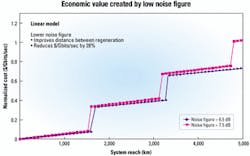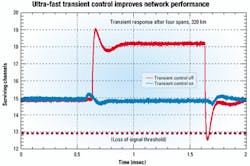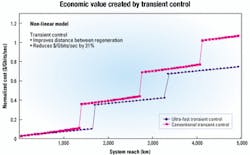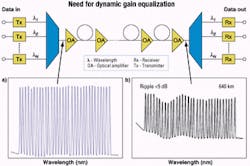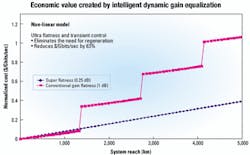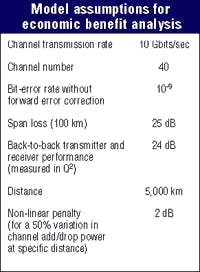The 'smart' money is on network intelligence
Intelligent optical engines and other advanced subsystems help service providers successfully deploy profitable next-generation optical networks.
ATUL SRIVASTAVA, CHIEN-JEN CHEN, and HORACIO FACCA, Onetta Inc.Today's network service providers face the challenge of competing in a time of unprecedented rivalry and great economic slowdown. They need to reduce customer churn while meeting their clients' growing bandwidth and service provisioning needs, yet still defend against competitive pressures from other service providers. Service providers must make continued improvements and investments in their optical-network infrastructure to maintain the service velocity and offerings that will differentiate them in the marketplace and ultimately put them back on the road to profitability.
Most service providers recognize that they must migrate from "static" to "dynamic" networks in order to intelligently and reliably support a broad range of service offerings, ranging from wavelength to virtual private-line services. Providers are currently using a combination of advanced optical transport, switching and routing technologies, bandwidth aggregation, and grooming techniques to deliver on these service offerings.
In the area of advanced optical transport solutions, intelligent optical engines, such as dynamic optical amplifiers and other advanced subsystems, can help metropolitan and long-haul service providers successfully deploy profitable next-generation optical networks. These networks can ease system design constraints, facilitate service provisioning, provide new revenue streams, and create economic value with lower costs in terms of cost, speed, and distance ($/Gbits/sec/km).
Intelligent optical components and subsystems play a significant role in helping network service providers deploy profitable optical networks. To assess the specific economic benefits of adding intelligence to optical subsystems, a comprehensive economic benefit analysis was conducted using established linear and non-linear transmission models.
The latter model is typically preferred, since it accounts for various non-linear penalties in a transmission system. The model is based on current DWDM networks operating at bit rates of 10 Gbits/sec per channel, with 40 channels at 100-GHz channel spacing over a transmission distance of up to 5,000 km. Key parameters, such as commission limit for bit-error rate (BER), span loss, back-to-back transmitter and receiver performance, and non-linear penalties were assumed, as shown in the Table on page 126.
Operational expenditures and new revenue-generating opportunities are additive to the analysis. Systematic gain ripple was assumed to have the same magnitude at various locations. This assumption represents a worst-case scenario for compounded systematic gain ripple. A non return-to-zero modulation format was assumed in the analysis as well. Also included were standard erbium-doped fiber amplifier (EDFA) specifications, such as input and output power, bandwidth, mid-stage loss, gain, polarization-dependent loss, and polarization-mode dispersion.The critical threshold for the non-linear model was triggered by a failure to maintain a BER of 10-9 in an add/drop scenario where the per-channel power changed by 50% from its nominal value. To eliminate the amplifier and electrical regeneration costs as variables, the costs were assumed to be constant and all final outputs were normalized to one standard condition. Finally, the model does not use forward error correction and Raman amplification, although these technologies could very well be integrated into intelligent optical engines in the future.
In an optically amplified transmission system, the channel power reaching a receiver at the end of a link is optically degraded by the accumulated amplified spontaneous emission (ASE) noise from the optical amplifiers in the chain. At the front end of the receiver, ASE noise is converted into electrical noise, primarily through signal-ASE beating, leading to degradation in BER and quality of service. Therefore, system performance places an important requirement on optical signal-to-noise ratio (OSNR) for each of the optical channels in a DWDM system.
OSNR subsequently becomes the most important design parameter for an optically amplified system. One of the key amplifier characteristics contributing to the end-of-system OSNR is the noise figure of the optical amplifiers constituting the system. The noise figure (NF) is a measure of the ASE noise added by an amplifier to the signal being amplified. The end-of-system OSNR is increased by 1 dB for every 1 dB of improvement in the NF.
In an OSNR-limited transmission system, an improvement in NF by 1 dB can be translated into additional 1-dB system margin, which could provide either 25% additional system reach or capacity. Additional margin can be derived from a system limited by non-linear effects, such as four-wave mixing. The lower noise figure can be used to lower the power of the signal launched in the fiber while maintaining the same OSNR at the end of the system.
Today's amplifiers have evolved to become fully integrated intelligent optical engines that incorporate multiple functions, such as spectral gain control, dispersion compensation, optical add/ drop functionality, and other key features. However, this improved functionality adds losses, which then need to be compensated for through additional gain in the amplifier while still maintaining high output power, wide bandwidth, and low noise figure. Fortunately, newly introduced multistage amplifiers have been designed to manage these requirements and have achieved noise figures as low as 6 dB.
One limitation of static networks (conventional SONET/SDH or even advanced DWDM) lies in their susceptibility to service impacting events, such as optical power transients. These transients are sub-millisecond fluctuations in network power levels typically caused by channel-loading changes, passive loss variations, and network protection switching.
Next-generation optical amplifiers that feature transient control can benefit network service providers targeting both metropolitan and long-haul markets. In metropolitan applications, they allow service providers to use efficient amplification to outweigh passive losses and accommodate unpredictable traffic patterns. In long-haul applications, carriers can cascade more optical amplifiers to overcome fiber loss-minimizing the need for costly regenerators.
These devices convert the signals from the optical domain to the electrical domain, typically reshaping, retiming, and reamplifying the signal before modulating lasers to convert the signal back from electrical to optical. Intelligent amplifiers also increase network reliability by preventing data loss during network upgrades, which can now be performed without service disruption.Even the most advanced DWDM systems can benefit from the adoption of intelligent optical engines. These new systems have imposed stringent performance requirements on optical amplifiers. The polarization dependence, noise figure, and gain flatness must all meet stringent standards in ultra-high-capacity, long-haul amplified systems.
As more amplifiers are cascaded in these systems, proportionally higher transient power spikes tend to occur. Without effective, dynamic, intelligent control, these transients can degrade system performance and negatively impact the reliability and flexibility of a service provider's network (see Figure 2).
Optical transients can create serious operational challenges for service providers, diminishing their profitability and ability to compete with world-class carriers. Even if service providers can count on fast physical-layer protection switching, without intelligent control built into the system, transients will not be detected quickly enough to prevent potentially severe system performance degradation.A costly work-around for the transient problem in network builds using conventional optical amplifiers is to allocate a significant amount of system margin to absorb the power fluctuations. This approach adds to the overall cost of the system, since the number of regenerators must be increased in order to compensate for the depleted system margin. A more cost-effective solution uses intelligent optical engines that can quickly adapt to sub-millisecond fluctuations in network power levels (see Figure 3).
Software-controlled network provisioning, combined with transient control, reduces the service provider's need to manually rebalance the network when dynamically changing the channel loading. That greatly enhances service velocity through the use of computer keystrokes instead of physical truck rolls.
The dynamic gain equalizer (DGE) is another key enabling technology for higher capacity, longer reach, more flexibility, and lower cost networks. The problem DGE addresses is channel-to-channel optical power variations, or ripple (see Figure 4). Ripple has many causes, including non-flatness of erbium gain, polarization-dependent loss, induced tilt from stimulated Raman scattering, and wavelength-dependent loss from multiplexers and other passive components.Ripple accumulates through the cascaded segments of a transmission system and leaves some channels with lower power and others with higher power, relative to the system design point. Lower power channels suffer OSNR degradation. If the OSNR penalty exceeds the system margin, the BER may begin to increase. This OSNR penalty limits the reach of a DWDM system and requires signal regenerators at intervals of approximately 500 km.
For instance, in long-haul networks carriers would like to increase the spacing between regenerators to several thousand km. In this scenario, the signal would have to pass through up to fifty amplifiers without electrical regeneration. These networks require intelligent amplifiers with the excellent gain uniformity that can be achieved using dynamic gain equalization filters. Higher power channels incur stimulated Brillouin scattering and other single-channel non-linearities such as self-phase modulation, cross-phase modulation, and four-photon mixing.
In this scenario, the highest power channels are the most degraded, whereas with four-photon mixing products such as ASE, the performance of the weakest channels is the most degraded. Additionally, large power divergence increases interchannel crosstalk at the optical demultiplexer output. If the power is either too high or too low, self-phase modulation and dispersion are not balanced, leading to short signal pulses that then spread out.
In a static optical-networking environment, existing remedies for ripple reduction include gain flattening filters (GFFs) in each amplifier, variable optical attenuators (VOAs) in the EDFA, clean-up filters, and fixed attenuators to trim power prior to multiplexing and launch at the start of the link. In seeking to maintain and sustain flatness in dynamic network environments, DGEs provide carriers with numerous advantages over these solutions.DGEs increase system margin, support higher bit rates, and enable longer fiber loss spans, thereby extending network reach. DGEs compensate for changes in Raman tilt after add/drop events and eliminate the need to manually replace custom clean-up filters. DGEs also allow relaxed amplifier specifications, thereby reducing their cost.
Dynamic gain equalization can reach the next level by integrating an intelligent filter with an optical monitor measuring input power for each channel and feeding forward an electronic signal to change the characteristics of the filter. Intelligent dynamic gain equalization enables network service providers to create dynamically, highly profitable, reconfigurable networks.
Intelligent dynamic gain equalization offers several benefits to network service providers. In addition to increasing the average span length between optical amplifiers and/or the distance between electrical regenerators in long-haul networks, it supports dynamic network reconfiguration in virtually all optical-networking deployments by making the OSNR independent of channel loading. Intelligent dynamic gain equalization allows the use of generic, rather than custom-designed, GFFs to lower the network equipment manufacturers' development time and costs.
These savings directly impact the network service provider who is trying to manage down capital and operating costs. DGEs also allow amplifier gain tilt to intelligently adapt to changes in input power, making it possible to eliminate the VOAs that perform this function today in conventional optical subsystems. Finally, intelligent dynamic gain equalization eliminates the need for custom cleanup filters commonly used in long-haul systems to remove accumulated gain ripple.
Next-generation optical networks are beginning to incorporate intelligence into the optical layer, through direct management and manipulation of wavelengths or through electronic processing. This additional optical layer functionality is now requiring the integration of intelligent optical-network subsystems and components.
Many components and subsystems in optical networking are candidates for intelligence. Almost every optical component and subsystem will contain, or be subject to, intelligent modes of operation.
Intelligent optical-networking engines, available and deployable today, have become a priority among industry-leading network equipment manufacturers and those who seek to displace them. The new intelligent optical subsystems with low noise figure, transient control, dynamic gain equalization, and optical channel monitors help address key transmission impairments, thereby allowing for much greater network flexibility and economic bandwidth delivery over longer distances.
Transient control allows a fiber-optic system to dynamically compensate for sub-millisecond fluctuations in network power levels caused by channel-loading changes, passive loss variations, and network protection switching. Transient control limits surviving channel power excursions, preventing potential quality-of-service degradation.Dynamic gain equalization addresses gain ripple in optical networking, enabling longer amplifier cascades and higher bit rates without electrical regeneration. DGEs support dynamic network reconfiguration by allowing reduced channel loadings without OSNR degradation and by eliminating the need for custom clean-up filters in long-haul systems.
Dynamic and reconfigurable, optical networks powered by intelligent optical engines can help service providers overcome current challenges by boosting revenues and reducing the time and cost to deploy, provision, and maintain networks. As feature-rich intelligent optical engines incorporate the benefits of low noise figure, ultra-fast transient control, dynamic gain equalization, and optical channel monitoring, increasingly more economic value is created in terms of $/Gbits/sec/km. Network equipment manufacturers have the opportunity to deliver these benefits to network service providers today to help rationalize their cost structures and improve profitability.
Atul Srivastava is chief scientist, Chien-Jen Chen is optical design manager, and Horacio Facca is the director of mar keting at Onetta Inc. (Sunnyvale, CA). They can be reached via the company's Website, www.onetta.com. Other contributors to this article include Gordon Wilson and William Wong, also of Onetta.


